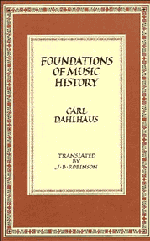Book contents
- Frontmatter
- Contents
- Translator's preface
- Foreword
- 1 Is history on the decline?
- 2 The significance of art: historical or aesthetic?
- 3 What is a fact of music history?
- 4 Does music history have a ‘subject’?
- 5 Historicism and tradition
- 6 Hermeneutics in history
- 7 The value-judgment: object or premise of history?
- 8 The ‘relative autonomy’ of music history
- 9 Thoughts on structural history
- 10 Problems in reception history
- Bibliography
- Index
2 - The significance of art: historical or aesthetic?
Published online by Cambridge University Press: 01 June 2011
- Frontmatter
- Contents
- Translator's preface
- Foreword
- 1 Is history on the decline?
- 2 The significance of art: historical or aesthetic?
- 3 What is a fact of music history?
- 4 Does music history have a ‘subject’?
- 5 Historicism and tradition
- 6 Hermeneutics in history
- 7 The value-judgment: object or premise of history?
- 8 The ‘relative autonomy’ of music history
- 9 Thoughts on structural history
- 10 Problems in reception history
- Bibliography
- Index
Summary
In an appendix to his extraordinarily widely read textbook, A History of Western Music, Donald Jay Grout offers a ‘Chronology’ designed ‘to provide a background for the history of music, and to enable the reader to see the individual works and composers in relation to their times’ (p. 699). Thus, for instance, the year 1843 is represented by The Flying Dutchman, Donizetti's Don Pasquale and Kierkegaard's Fear and Trembling, 1845 by Les préludes, Tannhäuser and Dumas' Count of Monte Cristo, 1852 by Uncle Tom's Cabin and Louis Napoléon's coup d'état, 1853 by La traviata and the Crimean War. However, it is unclear exactly what the reader is meant to conclude. Is there a subtle analogy between Wagner's opera and Kierkegaard's book? Or on the contrary, might it be that events which are extrinsically contemporaneous are, intrinsically, anything but contemporaneous, a conclusion made grotesquely and abundantly clear precisely when we use chronological tables in an attempt to illustrate the Zeitgeist that supposedly pervades all spheres of life at a given time? Does music mirror the reality surrounding a composer, or does it propose an alternative reality? Does it have common roots with political events and philosophical ideas; or is music written simply because music has always been written and not, or only incidentally, because a composer is seeking to respond with music to the world he lives in?
- Type
- Chapter
- Information
- Foundations of Music History , pp. 19 - 33Publisher: Cambridge University PressPrint publication year: 1983
- 2
- Cited by



